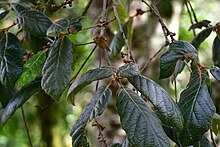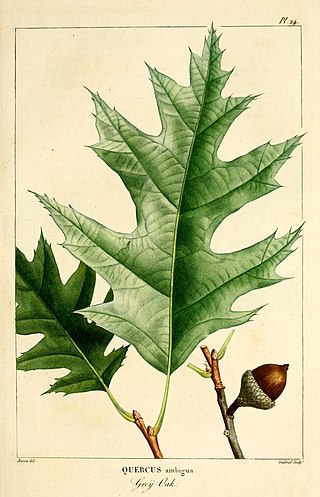
Quercus diversifolia is an uncommon North American species of oak native to Mexico. It has been found in the states of Nuevo León, Durango, México, and Puebla.

Quercus xalapensis, or xalapa oak, is a species of oak in the red oak group. It is native to the mountains of eastern and southern Mexico, as well as Guatemala, Honduras, and Nicaragua in northern Central America.

Quercus rugosa, commonly known as the netleaf oak, is a broad-leaved tree in the beech and oak family Fagaceae. It is native to southern North America.

Quercus glaucoides is an oak species in the white oak section, Quercus section Quercus, found in and endemic to eastern, central and southern Mexico.
Cephalanthus salicifolius is a species of flowering plant in the family Rubiaceae. Common names include Mexican buttonbush, mimbre, botoncillo, and Jazmin blanco. Its native range extends from the banks of the southernmost stretch of the Rio Grande in Cameron and Hidalgo Counties of Texas through much of Mexico from Coahuila to Oaxaca; a disjunct population exists in Honduras.

Quercus humboldtii, commonly known as the Andean oak, Colombian oak or roble, is a species of oak found only in Colombia and Panamá. It is named for Alexander von Humboldt.

Quercus laurina is a species of oak. It is native primarily to Mexico and has also been found in Guatemala and El Salvador.

Quercus magnoliifolia, also known as encino amarillo, encino avellano, encino bermejo, encino blanco, encino napis, encino prieto, and roble, is a Mexican species of oak. It is widespread along the Pacific Coast of Mexico from Sinaloa to Chiapas, and also found inland as far as Zacatecas and Puebla.
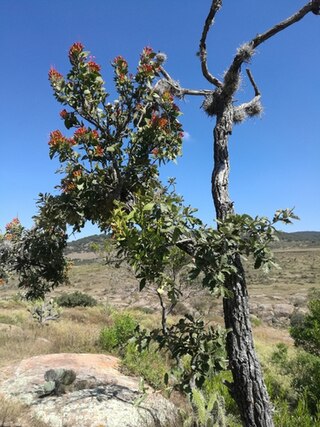
Quercus deserticola is a Mexican species of oaks in the beech family. It grows in central Mexico in the States of Guanajuato, México, Hidalgo, Jalisco, Querétaro, Oaxaca, Sinaloa, Puebla, and Michoacán.

Quercus laeta is an oak species in the white oak section, Quercus section Quercus, in the beech family. It is widespread across much of Mexico from Sinaloa and Nuevo León south as far as Oaxaca.

Quercus obtusata is an oak in the white oak group endemic to Mexico, with a distribution ranging from San Luis Potosí and Nayarit south to Oaxaca, from 620 to 2800 MSL.
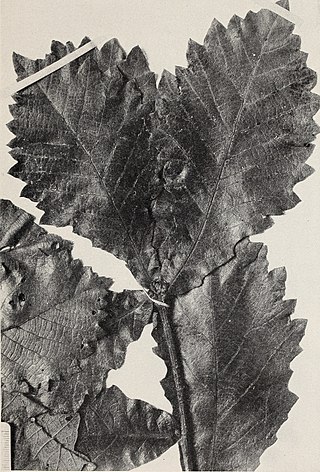
Quercus peduncularis is an oak native to Mexico and Central America, ranging from Jalisco to Honduras.
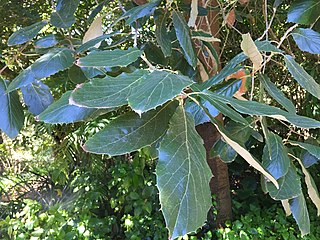
Quercus calophylla is a Mesoamerican species of oak tree. It is native to mountain forests of central and southern Mexico, Guatemala, and El Salvador. It has incorrectly been known as Quercus candicans.

Quercus castanea is a species of oak tree. It is widespread across much of Mexico, from Sonora to Chiapas, and in Guatemala, El Salvador, and Honduras.
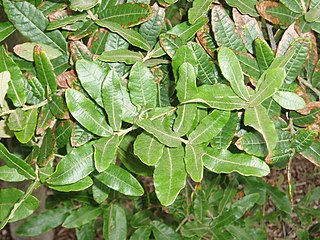
Quercus crassipes is a species of oak tree. It is widespread across much of Mexico from Sonora and Hidalgo south to Chiapas.
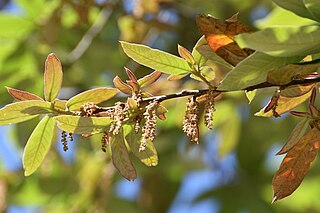
Quercus × dysophylla is a species of oak tree. It grows in central Mexico in Hidalgo, México State, D.F., Puebla, Michoacán, and San Luis Potosí. Its parents are Q. crassifolia and Q. crassipes, both members of section Lobatae.

Quercus elliptica is a Mesoamerican species of oak tree. It is widespread across central and southern Mexico and Central America from Sinaloa and Hidalgo south as far as Nicaragua. It is classified in Quercus sect. Lobatae.

Quercus mexicana is a species of oak. It is widespread in eastern Mexico from Chiapas to Tamaulipas.
Quercus scytophylla is a species of oak. It is native to western and central Mexico from Sonora and Chihuahua to Chiapas.

Quercus urbani, also known as Quercus urbanii, is a species of oak. It is native to western and central Mexico from Sinaloa, Durango, and Zacatecas to Oaxaca. It was previously synonymized with Quercus pennivenia, but this was restored as an independent species in 2020.
